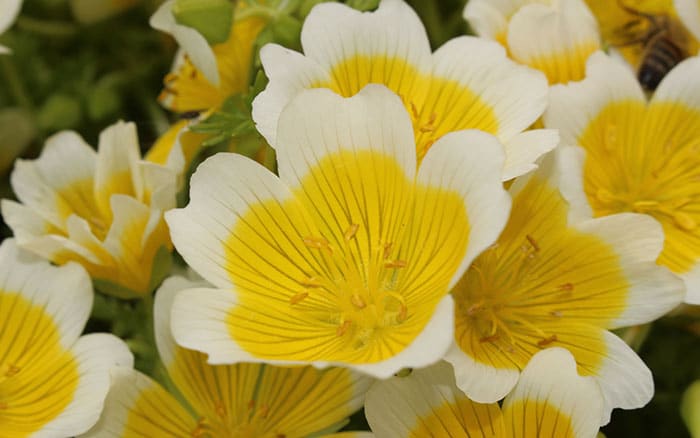These lovely blooming annuals look like they belong on the breakfast plate as much as the garden. Find out everything you need to know to grow Limnanthes douglasii, poached egg plant.
Plant Biography

BOTANICAL NAME
Limnanthes douglasii
COMMON NAME
Poached egg plant
NATIVE TO
Named for their white and yellow flowers, reminiscent of poached eggs, these plants are native to Oregon and California.
DESCRIPTION
Only short, up to 15 cm in height, Limnanthes bear cup-shaped blooms with white-tipped petals, yellow in the centre. Also, they have fresh green, fernlike foliage.
What type of plant is it?
These flowers are annuals.
What colours do poached egg plant come in?
Each flower is white and yellow.

When do these plants flower?
These are summer annuals, whose blooms can be enjoyed between May and July. Additionally, they are also known to flower in autumn, under favourable conditions.
Where does it like to grow?
Where does it dislike to grow?
They prefer not to be in full shade, to be in overly dry soil.
Is this plant drought-tolerant?
Yes, these plants are drought tolerant.
How to grow poached egg plant successfully

These plants are extremely easy and low-fuss to grow. Firstly, you simply need to sow the seeds onto moist, well-draining soil in spring or autumn. If sowing in autumn, make sure to protect them from the frost. Additionally, as annuals, they can be enjoyed for much of the summer and early autumn before dying back.
Do they require supports?
No, as low-growing annuals, poached egg plants do not require supports.
Is it good for pollinators?
Yes, they are. Limnanthes douglasii are particularly popular amongst bees, beneficial insects, and other pollinators frequenting the garden.

Is it good for wildlife?
Limnanthes douglasii do not have any particular benefits to garden wildlife, besides encouraging beneficial insects like hoverflies into the space.

How to choose the right variety for your garden
There is only one variety of Limnanthes douglasii, however, they are well suited to growing as groundcover and in containers. They can also be a wonderful asset in vegetable gardens, encouraging beneficial insects like hoverflies to deal with unwanted pests.
How big will it get
These plants will typically grow no bigger than 15cm tall, and 15cm wide.

How to plant poached egg plant
Limnanthes douglasii are best bought and sown as seed, which can be bought affordably at your local garden centre.
Simply sow them onto well-draining yet moist soil between April and July which will have access to full sun. Water in well, and they should start producing flowers as early as May, for April sowings.
If you do buy established poached egg plants, plant them out into the garden from May to no later than June.
How to care for poached egg plant
These plants are very low fuss, and simply require moist soil. Also, cut them back once they have finished flowering.
Do they spread?
These lovely cup-shaped blooms will self-seed and naturalise readily if allowed to.
How to keep it looking good
As low-growing annuals, poached egg plants don’t require any special attention to keep looking good. Just ensure they have all they need to stay healthy, and they should continue to look wonderful throughout the summer.

Do poached egg plants need deadheading?
No, poached egg plants won’t benefit from being deadheaded. They simply need to be cut back after flowering has ended.
Does it need pruning, and when should they be pruned?
No, Limnanthes douglasii won’t benefit from pruning.
How to propagate these plants
These annuals are easily propagated by seed, and will happily self-seed if left to their own devices.
What problems can poached egg plants have?
These delightful little plants are relatively trouble-free, with no pests or diseases that need keeping an eye out for. Simply ensure they have plenty of water and sunlight.
Varieties of poached egg plant to have
There are not many varieties of poached egg plants, with Limnanthes douglasii being the classic, recognisable variety. There is another variety, Limnanthes douglasii ‘Meringue’, which has a much smaller if no yellow ‘yolk’ centre, instead purely white petals.

Best time of year to buy this plant
Seeds can be purchased for this plant year-round, and established plants can be expected to be found in garden centres between May and July.
The best garden design style for this plant
Poached egg plants are suited to several garden styles. However, the best options include wildlife gardens, wildflower meadows, coastal, cottage, and courtyard gardens.


Leave A Comment